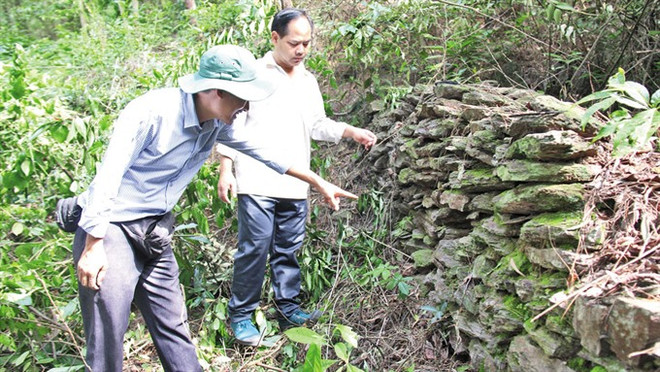 An excavation team from the Vietnam Institute of Archaeology and Bac Giang province Museum discovered valuable artifacts after a month-long excavation in the remnants of Ma Yen pagoda (Photo: baobacgiang.com.vn)
An excavation team from the Vietnam Institute of Archaeology and Bac Giang province Museum discovered valuable artifacts after a month-long excavation in the remnants of Ma Yen pagoda (Photo: baobacgiang.com.vn)Bac Giang (VNA) - An excavation team from the VietnamInstitute of Archaeology and the Bac Giang provincial Museum has discovered valuableartifacts after a month-long excavation in the remnants of Ma Yen pagoda.
These artifacts willserve as important evidence about the presence of an important Buddhistarchitectural structure hundreds of years ago.
Ma Yen pagoda is locatedin the northern province of Bac Lung commune, Luc Nam district of the northernprovince of Bac Giang.
Ma Yen is also the name of a mountain, shaped like ahorse’s saddle. This region has some ancient sites, including Hinh NhanMountain (which looks like a human being standing) or the Elephant Mountain,and is surrounded by the endless pine forest.
Doctor Trinh Hoang Hiepfrom the Vietnam Institute of Archaeology, leader of the excavation team, said,“Each artifact found has special value. It helps to clarify the relationshipbetween the relic and other structures of Truc Lam Zen in the past. The searchand evacuation has been done in a cautious and meticulous manner. Artifactsfound were carefully classified so that we could identify the number ofconstruction materials used in a specific period of time in an architecturalstructure. Artifacts were cleaned, recorded, reported and sent to theprovince’s museum.”
Construction materialsand daily items made of ceramics from different periods of time, in which theearliest was during the Tran dynasty (the 13th-14th century), were found.
“Early this year, wealso held an evacuation session but didn’t expect much because the pagoda hadbeen damaged by locals searching for antiques. But this time, the result was beyondour expectation,” said Hiep.
Vu Thi Sang, a native ofXuan Phu village, Bac Lung commune, said, “About 10 years ago, when localspassed by this area, they found artifacts and antiques under layers of fallingleaves. People then came to search for antiques and some thought there mighthave been valuable gold or silver items here; therefore, they brought metalseeking devices, digging back and forth to search for valuable items. Thisrelic, therefore, was seriously damaged.”
With a total excavationarea of 200sq metres, the archaeologists discovered different architecturalparts of the pagoda, which included the foundation, remnants of the mainceremonial hall, which included the staircases, gates, decorative tiles, bowls,plates and stone mortar.
Besides, an ancient welland the foundation of other large-scale structures were found scattered in anarea covering thousands of square metres. The excavation team said this couldhave been the accommodation of monks, the kitchen and the pre-ceremonial hall.
According to historicaldocuments, Ma Yen was built from the Ly-Tran dynasty (12th-13th century), yettill now, there is still not enough archaeological evidence to affirm that thestructure was built as early as during the Ly dynasty (the 11th).
With constructionmaterials and decorative patterns discovered, it can be identified that thestructure appeared during three periods of time, which included the Trandynasty (13th-14th century) with the discovery of the lotus petal-shaped stonebase (used as a pedestal for the pillar in a building), the Le Trung Hungdynasty (the 17th-18th century) and the Nguyen dynasty (19th century).
A common thing amongpagodas during the Tran dynasty is that their rear is protected by themountain, facing a big stream, and as such, their location was often in aremote high mountain peak and away from the residential area.
The foundation for thisstatement is that the pagoda used wood to build the surrounding wall. Duringthe excavation, there was no sign of brick found. It is very likely that peopleused wood from the forest to build the surrounding wall. With heavy, big tilesfound, it can be inferred that the pressure capacity of architectural items,like pillars, is quite strong. The structure used two types of stone, oneavailable in the area and used for the foundation and the other is sandstonefrom other localities used as the pedestal for pillars.
The excavation teamhopes to discover decorative items shaped like the bodhi leave, dragon orphoenix’s head, which were very popular in pagodas during the Tran dynasty.
With the artifacts foundand reference to historical documents, Ma Yen is considered as one of the greatheritage relics, and to have a connection with and be influenced by Truc LamZen from the Tran Dynasty, according to archaeologists.
Ma Yen lies to the westto the Yen Tu Mountain region, which was the founding place of Truc Lam Zen.
Yen Tu Mount, locatedmore than 1,000 metres above sea level, was found by King Tran Nhan Tong. Aftersuccessfully leading the Tran dynasty to its final victories over two Mongolinvasions, King Tran Nhan Tong gave the throne to his son and went to Yen Tu in1299 to create the Truc Lam Buddhism Zen Sect, which had a significant impacton the development of Vietnamese Buddhism. -VNA





























